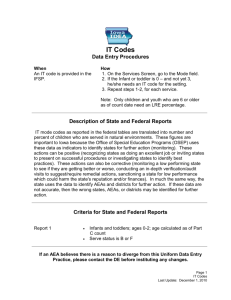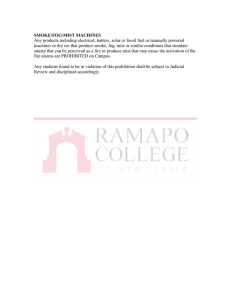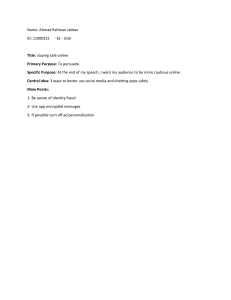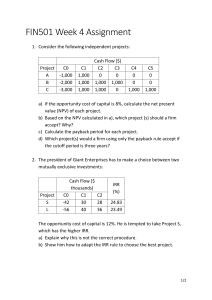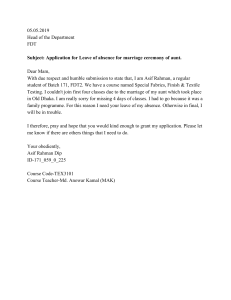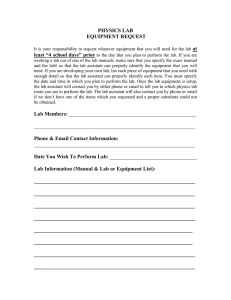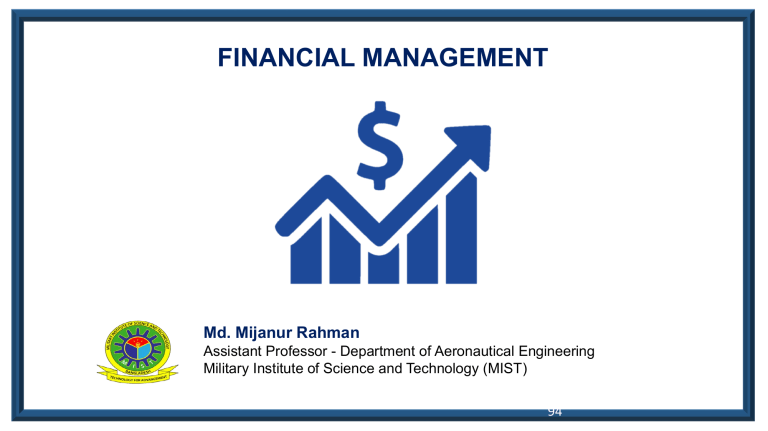
FINANCIAL MANAGEMENT Md. Mijanur Rahman Assistant Professor - Department of Aeronautical Engineering Military Institute of Science and Technology (MIST) 94 Financial Management Financial Management can be defined as the management of the finances of a business/organization in order to achieve financial objectives. It focuses on ratios, equities and debts. It is useful for portfolio management, distribution of dividend, capital raising, hedging and looking after fluctuations in foreign currency and product cycles. It also refers to the efficient and effective management of money (funds) in such a manner as to accomplish the objectives of the organization. It is the specialized function directly associated with the top management. Financial management may be defined as that area or set of administrative function in an organization which are related with arrangement of cash and credit so that organization may have the means to carry out its objective as satisfactorily as possible. - by Howard & Opton. AEAS 445 - Industrial and Business Management © Assistant Professor Md. Mijanur Rahman – MIST 95 Objectives of Financial Management Primary Objective: Maximization of Shareholder’s Wealth Can be further broken down as follows Liquidity Deciding the amount of Liquid resources will be needed and arranging the same. Profitability Setting objective for a level of profitability high enough to attract new capital to the business, to reassure creditors, shareholders and employees Efficiency To increase financial output from a given input/ output. Growth Increasing the value of business by growth, expansion, merger or acquisition. Return on Capital To ensure future economic benefits for the present cash outflow. AEAS 445 - Industrial and Business Management © Assistant Professor Md. Mijanur Rahman – MIST 96 Key Elements of Financial Management Financial Planning: Management needs to ensure that enough funding is available at the right time to meet the needs of the business. In the short term, funding may be needed to invest in equipment and stocks, pay employees and fund sales made on credit. In the medium and long term, funding may be required for significant additions to the productive capacity of the business or to make acquisitions. Financial Control: Financial control is a critically important activity to help the business ensure that the business is meeting its objectives. Financial control addresses questions such as: • Are assets being used efficiently? • Are the businesses assets secure? • Do management act in the best interest of shareholders and in accordance with business rules? Financial Decision-Making: The key aspects of financial decision-making relate to investment, financing and dividends: • Investments must be financed in some way − however there are always financing alternatives that can be considered. For example it is possible to raise finance from selling new shares, borrowing from banks or taking credit from suppliers • A key financing decision is whether profits earned by the business should be retained rather than distributed to shareholders via dividends. If dividends are too high, the business may be starved of funding to reinvest in growing revenues and profits further. AEAS 445 - Industrial and Business Management © Assistant Professor Md. Mijanur Rahman – MIST 97 Financial Performance Analysis of Organizations Financial analysis is a method or process involving specific techniques for evaluating risks, performance, financial health, and future prospects of an organization. It is used by a variety of stakeholders, such as credit and equity investors, the government, the public, and decision-makers within the organization. equity investors are interested in the long-term earnings power of the organization and perhaps the sustainability and growth of dividend payments. • Horizontal Analysis: Horizontal analysis compares financial information over time, typically from past quarters or years. Horizontal analysis is performed by comparing financial data from a past statement, such as the income statement. When comparing this past information one will want to look for variations such as higher or lower earnings. • Vertical Analysis: Vertical analysis is a percentage analysis of financial statements. Each line item listed in the financial statement is listed as the percentage of another line item. For example, on an income statement each line item will be listed as a percentage of gross sales. This technique is also referred to as normalization or common-sizing. • Financial Ratio Analysis: Financial ratios are very powerful tools to perform some quick analysis of financial statements. There are four main categories of ratios: liquidity ratios, profitability ratios, activity ratios and leverage ratios. These are typically analyzed over time and across competitors in an industry. AEAS 445 - Industrial and Business Management © Assistant Professor Md. Mijanur Rahman – MIST 98 Related Accounting Terms Basic Definition • Accounting: process of identifying, measuring, and communicating financial data • Financial accounting: provides information to external users • Managerial accounting: provides frequent operational data and information to internal users Basic Accounting Principles • Balance sheet: a financial report that gives a status report of assets, liabilities, and equity as of a specific date (used to show changes and the ability to pay debts) • Income statement: a financial report of revenues and expenses for a time period (used to analyze success). • Matching: account for revenues and expenses in same period. • Depreciation: lowering the value of an asset as it ages. AEAS 445 - Industrial and Business Management © Assistant Professor Md. Mijanur Rahman – MIST 99 Related Accounting Terms • Assets (what is owned) • Current assets: Cash, Accounts receivable (owed by customers), Inventory, Prepaid insurance • Fixed assets: Plant and equipment minus depreciation, Property etc. • Liabilities (what is owed) • Current liabilities • Accounts payable (bills from suppliers) • Accrued taxes or taxes payable (owed, but not paid) • Accrued expenses (owed, but not paid) • Deferred revenues (advanced payments) • Notes payable (short-term loans) • Long-term liabilities • Mortgage loan • Equity (investment) • Funds invested • Retained earnings (net worth minus withdrawals) AEAS 445 - Industrial and Business Management © Assistant Professor Md. Mijanur Rahman – MIST 100 Examples of Income Sources and Expenses Income Sources • Advertising • Conference sharing • Corporate sponsorships • Donations and gifts • Facility rentals • Fund raising events • Guarantees • Institutional support • Investment income • Luxury boxes • Merchandise sales • Parking fees • Premium seating • Program sales • Television rights fees • Ticket sales Expenses • Salaries and benefits • Cheerleaders • Equipment • Insurance • Recruiting • Uniforms & Utilities • Advertising and printing • Athletic training supplies • Capital expenses • Facility maintenance • General and administrative • Loan and interest repayment • Marketing • Media and community relations • Transportation, lodging, and food AEAS 445 - Industrial and Business Management © Assistant Professor Md. Mijanur Rahman – MIST 101 Sample Balance Sheet AEAS 445 - Industrial and Business Management © Assistant Professor Md. Mijanur Rahman – MIST 102 Sample Income Statement AEAS 445 - Industrial and Business Management © Assistant Professor Md. Mijanur Rahman – MIST 103 Financial Ratio Analysis • Liquidity ratios: are used to determine how quickly a company can turn its assets into cash if it experiences financial difficulties or bankruptcy. It is essentially is a measure of a company's ability to remain in business. • Cash and cash equivalents refers to the line item on the balance sheet that reports the value of a company's assets that are cash or can be converted into cash immediately. Cash equivalents include bank accounts and marketable securities, which are debt securities with maturities of less than 90 days. • Short-term investments, also known as marketable securities or temporary investments, are those which can easily be converted to cash, typically within 5 years. Many short-term investments are sold or converted to cash after a period of only 3-12 months. Some common examples of short term investments include Current accounts, high-yield savings accounts, government bonds and Treasury bills. Usually, these investments are high-quality and highly liquid assets or investment vehicles. AEAS 445 - Industrial and Business Management © Assistant Professor Md. Mijanur Rahman – MIST 104 Financial Ratio Analysis • Profitability ratios: are ratios that demonstrate how profitable a company is. A few popular profitability ratios are the breakeven point and gross profit ratio. The breakeven point calculates how much cash a company must generate to break even with their start up costs. The gross profit ratio is equal to gross profit/revenue. This ratio shows a quick snapshot of expected revenue. • Gross Profit is the income left after deducting direct expenses; • Operating Profit is the income remained after deducting indirect expenses from gross profit • Net Profit is the net of all expenses, interest, and taxes. AEAS 445 - Industrial and Business Management © Assistant Professor Md. Mijanur Rahman – MIST 105 Cash Flows Engineering projects generally have economic consequences that occur over an extended period of time. For example, if an expensive piece of machinery is installed in a plant were brought on credit, the simple process of paying for it may take several years. The resulting favorable consequences may last as long as the equipment performs its useful function. Each project is described as cash receipts or disbursements (expenses) at different points in time. The expenses and receipts due to engineering projects usually fall into one of the following categories: Cash OutFlow • First cost: expense to build or to buy and install • Operations and maintenance: annual expense, such as electricity, labor, and minor repairs • Overhaul: major capital expenditure that occurs during the asset’s life Cash Inflow • Revenues: annual receipts due to sale of products or services • Salvage value: receipt at project termination for sale or transfer of the equipment AEAS 445 - Industrial and Business Management © Assistant Professor Md. Mijanur Rahman – MIST 106 Cash Flow Diagram In a cash flow diagram (CFD) • Beginning of period cash flows are: Rent, Lease, And Insurance Payments • End-of-period cash flows are: Salvages, Revenues, Overhauls The choice of time 0 is arbitrary. It can be when a project is analyzed, when funding is approved, or when construction begins • One person’s cash outflow (represented as a negative value) is another person’s inflow (represented as a positive value) Example: A man borrowed $1,000 from a bank at 8% interest. Two end-of-year payments: at the end of the first year, he will repay half of the $1000 principal plus the interest that is due. At the end of the second year, he will repay the remaining half plus the interest for the second year. Draw the cash flow diagram. Solution: • End of year Cash flow • 0 +$1000 • 1 -$580 (-$500 - $80) • 2 -$540 (-$500 - $40) AEAS 445 - Industrial and Business Management © Assistant Professor Md. Mijanur Rahman – MIST 107 Sample Problem Which is the better financial option for an Airline in a 5 year business model? Option 1: Purchase Aircraft Purchase cost = $ 120K O&M cost = $ 30K per year Overhaul cost = $ 35K after 3 years Salvage value = $ 40K after 5 years Option 2: Lease Aircraft The lease payments will be $25K per year. Total Cash Outflow in Option 1 120+30+30+30+35+30-40 = $ 235K O&M cost = $ 30K per year Overhaul cost = $ 35K after 3 years Total Cash Outflow in Option 2 25+25+30+25+30+25+30+35+25+30+30 = $ 310K Answer: Option 1 is Better AEAS 445 - Industrial and Business Management © Assistant Professor Md. Mijanur Rahman – MIST 108 Time Value of Money Money received sooner rather than later allows one to use the funds for investment or consumption purposes. This concept is referred to as the Time Value Of Money!! TIME allows one the opportunity to postpone consumption and earn INTEREST. How can one compare amounts in different time periods? • One can adjust values from different time periods using an interest rate. • Remember, one CANNOT compare numbers in different time periods without first adjusting them using an interest rate. What is the difference between future value and present value? • • Present value (PV) is the current value of future cash flow. Future value (FV) is the value of cash flow after a specified period. A simple way to classify whether cash flows are present value or future value is to remember that: • • PV is the value at the beginning of a time period that you are considering. FV is the value at the end of the time period that you are considering AEAS 445 - Industrial and Business Management © Assistant Professor Md. Mijanur Rahman – MIST 109 Simple and Compound Interest Simple Interest Compound Interest Interest paid (earned) on only the original Interest paid (earned) on any previous interest amount, or principal, borrowed. earned, as well as on the principal borrowed. With simple interest, the interest calculated for The standard assumption is that interest is years 2, 3,... is based on the initial deposit. There computed on the current balance which includes is no interest computed on the accrued interest. accrued interest that has not yet been paid. Terminology: i : interest rate per year n : number of years P : initial deposit, or Present Value F : future value after N years AEAS 445 - Industrial and Business Management © Assistant Professor Md. Mijanur Rahman – MIST 110 Simple and Compound Interest • Example: P=$1000, i=10%, compounded annually. How much accrued after one year? Solution: F = P + I = P + i P = P ( 1+i ) • Example: P=$1000, i=10%, compounded annually. How much accrued after two years? Solution: F = P + I1 + I2 = P + P i + (P + P i ) i = P ( 1+i ) 2. In general: F = P(1+i)n AEAS 445 - Industrial and Business Management © Assistant Professor Md. Mijanur Rahman – MIST 111 Converting Effective Interest Rates • Match cash flows and interest rate by converting rate to proper period. • Suppose the annual rate is i% but cash flows occur monthly • Convert effective annual rate to effective monthly rate. Example: Cash flows occur every month. Given annual interest rate of 12%. Find monthly interest rate. F Solution: F=P(1+ia) F=P(1+im)12 (1+ia) = (1+im)12 im=1.121/12 -1=.00949=.949% Annual Rate 0 1 year 1 2 3 Monthly Rate P 12 months Example: Cash flows occur every year. Given quarterly interest rate of 4 %. Find annual interest rate. Solution: F=P(1+ia) F=P(1+iq)4 (1+ia) = (1+iq)4 (1+ia) = (1+.04)4 ia=1.044 -1=.1699=16.99% Annual Rate 0 F 1 year 1 P 2 3 4 quarters Quarterly Rate AEAS 445 - Industrial and Business Management © Assistant Professor Md. Mijanur Rahman – MIST 112 Annuity Annuity is a special case of multiple cash flows where the cash flows are equal for a fixed period of time and the cash flows are at the end of each period. The equal amount of cash flows is called annuity payment or payment denoted by A. A company is receiving $ 8000 per year at an interest rate of 10% for 3 years. You can see that the total present value of the payments is $19,894.82. You can always value an annuity by calculating the present value of each cash flow and finding the total. However, it is usually quicker to use the following simple formula Present Value of n year Annuity, The expression in brackets shows the present value of a n -year annuity of $1 starting in period 1. It is generally known as the n -year annuity factor . Therefore, another way to write the value of an annuity is Present value of n-year annuity = Payment × Annuity factor AEAS 445 - Industrial and Business Management © Assistant Professor Md. Mijanur Rahman – MIST 113 Sample Problem Draw the cash flow diagram if Strong Metalworking borrows $1000, to be repaid in 5 years. The interest rate is 10%, and no payments are made before the end of year 5. Compute the payment after 5 years. Compute the payments at an interest rate of (i) 7% (ii) 11% and (iii) 15%. Solution: year 0 1 2 3 4 5 7% 1000 1070 1145 1225 1311 1403 Payment with Interest 11% 1000 1110 1232 1368 1518 1685 AEAS 445 - Industrial and Business Management © Assistant Professor Md. Mijanur Rahman – MIST 15% 1000 1150 1323 1521 1749 2011 114 Sample Problem If $840 is invested at 6% on January 1, 1987, what equal year end withdrawals can be made each year for 10 years to leave nothing in the fund after the tenth withdrawal? Draw the cash flow diagram. Solution: i=0.06, n=10, P=$840, A = ? A 1 i 1 P i (1 i)n P or A $114.1 n i (1 i)n 1 i 1 n A=$114 n = 10 P=$840 AEAS 445 - Industrial and Business Management © Assistant Professor Md. Mijanur Rahman – MIST 115 Sample Problems Draw the cash flow diagram if Strong Metalworking repays a $1000 loan with 5 annual payments of $263. Using Annuity formula, show that this repays the loan at an interest rate of 10%. Compute the present worth of the principal and interest payments in at an interest rate of (i) 10% (ii) 07% (iii) 11% (iv) 15% Solution: In case of Annuity Present Value P = $ 1000, n = 5 and Annual Payments A = 263 We know Annuity Formula Solving for A gives A = $ 997 (Almost 1000) Hence, it repays the loan at interest rate of 10% AEAS 445 - Industrial and Business Management © Assistant Professor Md. Mijanur Rahman – MIST 116 Sample Problems Table for present worth of the principal and interest payments in at an interest rate of (i) 10% (ii) 07% (iii) 11% (iv) 15%. Present Value = Future Value x (1+Rate of Interest)^No of Years AEAS 445 - Industrial and Business Management © Assistant Professor Md. Mijanur Rahman – MIST 117 Exercise • Exercise: Draw the cash flow diagram if Strong Metalworking borrows $100,000, to be repaid in 5 years. The interest rate is 11%, and no payments are made before the end of year 5. Compute the present worth of the principal and interest payments at an interest rate of (i) 7% (ii) 11% and (iii) 15%. Answer: $120K • Exercise: Draw the cash flow diagram if Strong Metalworking issues a $100,000 bond that pays 11% annual interest. The bond is repaid in 5 years. Compute the present worth of the principal and interest payments at an interest rate of (i) 7% (ii) 11% and (iii) 15%. Answer: $116.4K • Exercise: Draw the cash flow diagram if Strong Metalworking repays a $100,000 loan with 5 annual payments of $27,057. Construct an interest table to show that this repays the loan at an interest rate of 11%. Compute the present worth of the principal and interest payments in at an interest rate of (i) 7% (ii) 11% and (iii) 15%. Answer: $110.94K AEAS 445 - Industrial and Business Management © Assistant Professor Md. Mijanur Rahman – MIST 118 Payback Period (PBP) The payback period refers to the amount of time it takes to recover the cost of an investment. Simply put, the payback period is the length of time an investment reaches a break-even point. The desirability of an investment is directly related to its payback period. Shorter paybacks mean more attractive investments. Assume Company A invests $1 million in a project that is expected to save the company $250,000 each year. The payback period for this investment is four years—dividing $1 million by $250,000. AEAS 445 - Industrial and Business Management © Assistant Professor Md. Mijanur Rahman – MIST 119 Sample Problem A company is trying to decide which of the two machines, A and B, to purchase. Each of these machines costs Tk. 1,50,000.00. Earning after taxation is expected to be as follows: Cash flow Year Machine A (Tk.) Machine B (Tk.) 1 35,000.00 15,000.00 2 45,000.00 35,000.00 3 55,000.00 45,000.00 4 35,000.00 65,000.00 5 25,000.00 45,000.00 Indicate which of the machines would be chosen on the basis of payback method of ranking investment proposals. AEAS 445 - Industrial and Business Management © Assistant Professor Md. Mijanur Rahman – MIST 120 Sample Problem Solution: The calculation of payback period is shown as follows: Machine A Machine B Cash Flow, Tk. Year Payback Period Actual Balance 1 2 3 35000 45000 55000 115000 70000 15000 4 35000 5 25000 Total Cash Flow, Tk. Payback Period Actual Balance 1 year 1 year 1 year 15000 35000 45000 135000 100000 55000 1 year 1 year 1 year - (12/35000)x15000 = 5 Months 65000 - (12/65000)x55000 = 10 Months - - 45000 - - 150000 3 years 5 months 150000 3 years 10 months As PBP of Machine A is less that Machine B, Hence, Machine A should be chosen. AEAS 445 - Industrial and Business Management © Assistant Professor Md. Mijanur Rahman – MIST 121 Exercise The cash flow streams for four alternative investment A, B, C, and D are: Year A (Tk.) B (Tk.) C (Tk.) D (Tk.) 0 -2,00,000 -3,00,000 -2,10,000 -3,20,000 1 45,000 95,000 90,000 2,00,000 2 45,000 85,000 55,000 85,000 3 45,000 75,000 60,000 95,000 4 45,000 85,000 55,000 - 5 45,000 85,000 45,000 50,000 Indicate which of the investment would be chosen on the basis of payback method and rank 1,2,3 and 4 accordingly. AEAS 445 - Industrial and Business Management © Assistant Professor Md. Mijanur Rahman – MIST 122 Net Present Value (NPV) NPV is the difference between the present value (PV) of the future cash flows from an investment and the amount of investment. Present value of the expected cash flows is computed by discounting them at the required rate of return (also called minimum rate of return). NPV C0 Ct C1 C2 ... (1 r)1 (1 r)2 (1 r)t C = Cash Flow t = Time of the cash flow or time period of the investment r = Discount rate (the rate of return) For example, an investment of $1,000 today at 10% will yield $1,100 at the end of the year; therefore, the present value of $1,100 at the desired rate of return (10%) is $1,000. The amount of investment ($1,000 in this example) is deducted from this figure to arrive at NPV which here is zero ($1,000$1,000). • A zero NPV = Project repays original investment plus the required rate of return. • A positive NPV = Better return (Profit), • A negative NPV = Worse return, than the return from zero NPV (Loss). AEAS 445 - Industrial and Business Management © Assistant Professor Md. Mijanur Rahman – MIST 123 Sample Problem A company is trying to decide which of the two machines, A or B, to purchase. Each of these machines costs Tk. 150000.00. the expected net incremental cash flow are given below: Year 1 2 3 4 Machine A 35,000.00 45,000.00 55,000.00 35,000.00 Machine B 15,000.00 35,000.00 45,000.00 65,000.00 The company’s cost of capital is 6 percent per annum. Calculate the NPV of each machine. Indicate which machine should be purchased on the basis of NPV method of ranking investment proposal. Solution: 35000 45000 55000 35000 3025 1 2 3 4 (1 .06 ) (1 .06 ) (1 .06 ) (1 .06 ) 15000 35000 45000 65000 150000 5995 1 2 3 4 (1 .06 ) (1 .06 ) (1 .06 ) (1 .06 ) NPV A 150000 NPV B Comparing the two NPV, the NPV of Machine A is greater and should be purchased. AEAS 445 - Industrial and Business Management © Assistant Professor Md. Mijanur Rahman – MIST 124 Exercise A company is trying to decide which of the two machines, A or B, to purchase. Each of these machines costs Tk. 10000.00. The expected net incremental cash flow are given below: Year 1 2 3 4 Machine A (Tk.) 3000.00 3000.00 7000.00 6000.00 Machine B (Tk.) 6000.00 6000.00 3000.00 3000.00 The company’s cost of capital is 15 percent per annum. Calculate the NPV of each machine. Indicate which machine should be purchased on the basis of NPV method of ranking investment proposal. AEAS 445 - Industrial and Business Management © Assistant Professor Md. Mijanur Rahman – MIST 125 Required Rate of Return The required rate of return is the minimum return an investor will accept for owning a company's stock, as compensation for a given level of risk associated with holding the stock. The RRR is also used in corporate finance to analyze the profitability of potential investment projects. The required rate of return is also known as the hurdle rate, which like RRR, denotes the appropriate compensation needed for the level of risk present. AEAS 445 - Industrial and Business Management © Assistant Professor Md. Mijanur Rahman – MIST 126 Internal Rate of Return (IRR) IRR is the The discount rate that gives the project a zero NPV is known as the project’s internal rate of return, or IRR. It is also called the discounted cash-flow (DCF) rate of return. Solving for IRR gives, IRR = 12.56% The rate of return rule tells you to accept a project if the rate of return exceeds the opportunity cost of capital. If Cost of Capital < IRR = Project is Profitable. AEAS 445 - Industrial and Business Management © Assistant Professor Md. Mijanur Rahman – MIST 127 Evaluating Projects using NPV and IRR There are 2 basic rules to decide regarding investment: 1. The NPV rule. Invest in any project that has a positive NPV when its cash flows are discounted at the opportunity cost of capital. (Tell you whether you will be making money or not?) 2. The IRR rule. Invest in any project offering a rate of return that is higher than the opportunity cost of capital. (Tells you at what cost will you be making the money) Example: You planned to invest $350,000 to get back a cash flow of C 1 = $400,000 in 1 year. The alternative of investing in a U.S. Treasury bill would provide a return of only 7%. Thus the return is higher than the opportunity cost of capital. Hence, this investment is worth accepting. AEAS 445 - Industrial and Business Management © Assistant Professor Md. Mijanur Rahman – MIST 128 Evaluating Projects using NPV and IRR Which proposal Should be Accepted? Both projects are good investments; both offer a positive NPV. The Initial Proposal has higher IRR But the revised proposal has the higher net present value . In the Initial Proposal, you have the satisfaction of earning a higher 14.29% rate of return; In Revised Porposal, you are nearly $9,110 richer. ($57,942 - $23,832 = $34,110 higher NPV than Initial Proposal. And $34,110 - $25,000 = $9,110 higher Net Value. Note that Revised proposal has $25000 higher initial investment) AEAS 445 - Industrial and Business Management © Assistant Professor Md. Mijanur Rahman – MIST 129 Evaluating Projects using NPV and IRR The Figure shows that the IRR rule gives the wrong signal. The figure plots the NPV of each project for different discount rates. These two NPV profiles cross at an interest rate of 11.72%. So if the opportunity cost of capital is higher than 11.72%, the initial proposal, with its rapid cash inflow, is the superior investment. If the cost of capital is lower than 11.72%, then the revised proposal dominates. AEAS 445 - Industrial and Business Management © Assistant Professor Md. Mijanur Rahman – MIST 130 Learn Finances be the Wolf of your own Street AEAS 445 - Industrial and Business Management © Assistant Professor Md. Mijanur Rahman – MIST 131
